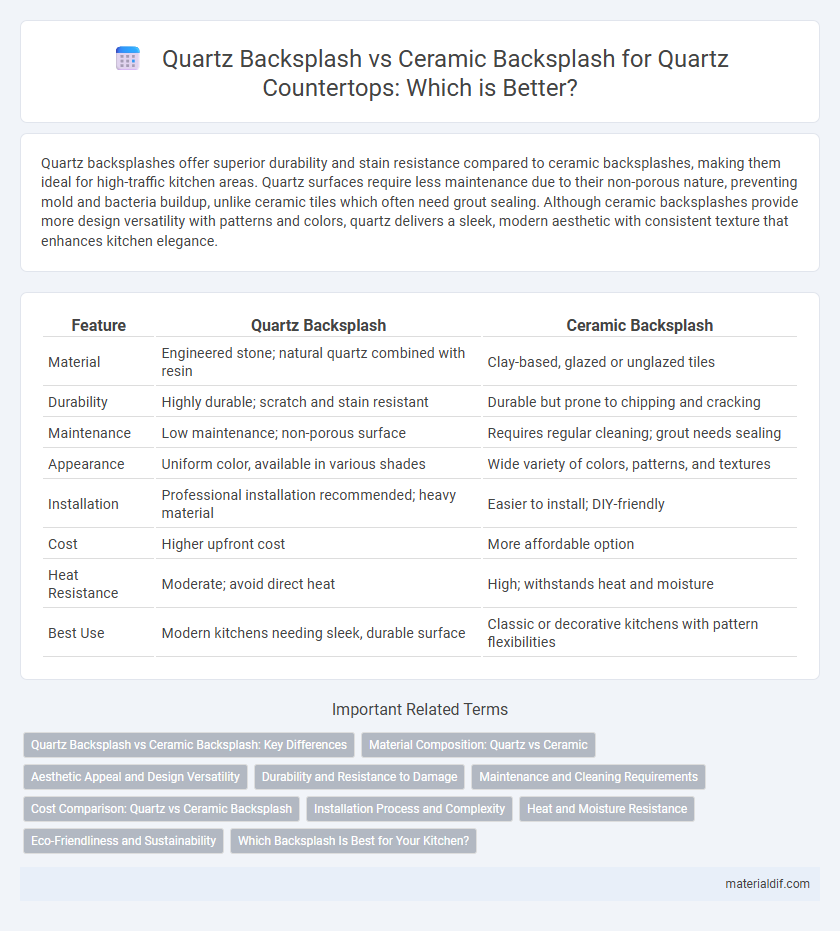Quartz backsplashes offer superior durability and stain resistance compared to ceramic backsplashes, making them ideal for high-traffic kitchen areas. Quartz surfaces require less maintenance due to their non-porous nature, preventing mold and bacteria buildup, unlike ceramic tiles which often need grout sealing. Although ceramic backsplashes provide more design versatility with patterns and colors, quartz delivers a sleek, modern aesthetic with consistent texture that enhances kitchen elegance.
Table of Comparison
| Feature | Quartz Backsplash | Ceramic Backsplash |
|---|---|---|
| Material | Engineered stone; natural quartz combined with resin | Clay-based, glazed or unglazed tiles |
| Durability | Highly durable; scratch and stain resistant | Durable but prone to chipping and cracking |
| Maintenance | Low maintenance; non-porous surface | Requires regular cleaning; grout needs sealing |
| Appearance | Uniform color, available in various shades | Wide variety of colors, patterns, and textures |
| Installation | Professional installation recommended; heavy material | Easier to install; DIY-friendly |
| Cost | Higher upfront cost | More affordable option |
| Heat Resistance | Moderate; avoid direct heat | High; withstands heat and moisture |
| Best Use | Modern kitchens needing sleek, durable surface | Classic or decorative kitchens with pattern flexibilities |
Quartz Backsplash vs Ceramic Backsplash: Key Differences
Quartz backsplash offers superior durability and non-porous surface, resisting stains and scratches better than ceramic backsplash, which can chip and requires sealing. Quartz provides a sleek, consistent appearance due to its engineered composition, while ceramic backsplash features a more varied, handcrafted look with grout lines prone to discoloration. Maintenance for quartz backsplashes is easier, demanding only simple cleaning without harsh chemicals compared to ceramic's periodic grout sealing and careful upkeep.
Material Composition: Quartz vs Ceramic
Quartz backsplash is engineered from natural quartz crystals combined with resin and pigments, offering durability and non-porous properties that resist stains and scratches. Ceramic backsplash consists of clay that is shaped and fired at high temperatures, resulting in a hard but more porous surface that can absorb moisture and is prone to chipping. The composition of quartz provides enhanced strength and low maintenance, while ceramic offers versatility in design but requires regular sealing to prevent damage.
Aesthetic Appeal and Design Versatility
Quartz backsplashes offer a sleek, modern aesthetic with consistent patterns and a polished finish, enhancing contemporary kitchen designs. Ceramic backsplashes provide a wider variety of colors, textures, and intricate patterns, allowing for more creative and traditional design options. The non-porous nature of quartz ensures stain resistance and durability, while ceramic tiles excel in customizable layouts and ease of replacement.
Durability and Resistance to Damage
Quartz backsplashes offer superior durability due to their non-porous surface and resistance to scratches, stains, and heat, making them ideal for heavy-use kitchens. Ceramic backsplashes, while also resistant to heat and stains, are more prone to cracking and chipping under impact due to their brittle nature. Quartz's engineered composition ensures long-lasting performance and low maintenance compared to ceramic alternatives, which may require more frequent repairs and grout upkeep.
Maintenance and Cleaning Requirements
Quartz backsplash boasts non-porous surfaces that resist stains, dirt, and bacteria, making maintenance simple with just mild soap and water. Ceramic backsplash requires regular sealing to prevent moisture infiltration and grout discoloration, demanding more frequent cleaning and upkeep. Quartz's durability and low maintenance make it an ideal choice for kitchens seeking long-term cleanliness and easy care.
Cost Comparison: Quartz vs Ceramic Backsplash
Quartz backsplashes typically cost between $70 and $100 per square foot, reflecting their durability and luxurious appearance, while ceramic backsplashes range from $5 to $15 per square foot, making them a budget-friendly option. Installation expenses for quartz are higher due to the material's weight and need for specialized tools, often doubling the total cost compared to ceramic. Despite the initial investment, quartz offers greater longevity and resistance to stains and scratches, potentially reducing long-term maintenance expenses.
Installation Process and Complexity
Quartz backsplash installation requires precise cutting and specialized tools due to its hardness and density, often necessitating professional expertise to avoid damage. Ceramic backsplashes are relatively easier to install with standard tile cutters and adhesives, making them more suitable for DIY projects. The complexity of quartz installation typically results in higher labor costs and longer project timelines compared to ceramic.
Heat and Moisture Resistance
Quartz backsplashes offer superior heat and moisture resistance compared to ceramic backsplashes, making them ideal for kitchens with high temperature fluctuations and frequent exposure to steam. Quartz's non-porous surface prevents water absorption and resists staining and warping caused by moisture. Ceramic backsplashes, while heat resistant to an extent, are more prone to cracking or grout damage under extreme heat and prolonged moisture contact.
Eco-Friendliness and Sustainability
Quartz backsplashes offer superior eco-friendliness by utilizing natural quartz, a durable and abundant mineral with low environmental impact during extraction. Ceramic backsplashes often involve high-energy kiln firing and raw material extraction that can contribute to greater carbon emissions and resource depletion. Choosing quartz supports sustainability through its long lifespan, minimal waste generation, and potential for recycling in construction projects.
Which Backsplash Is Best for Your Kitchen?
Quartz backsplashes offer unparalleled durability, resistance to stains, and a sleek, modern appearance, making them ideal for high-traffic kitchens where longevity is essential. Ceramic backsplashes provide a versatile range of colors and patterns, are cost-effective, and resistant to heat and moisture, perfect for budget-conscious homeowners seeking customizable designs. Choosing the best backsplash for your kitchen depends on prioritizing durability and maintenance ease with quartz or opting for affordable style variety and traditional charm with ceramic.
Quartz Backsplash vs Ceramic Backsplash Infographic

 materialdif.com
materialdif.com